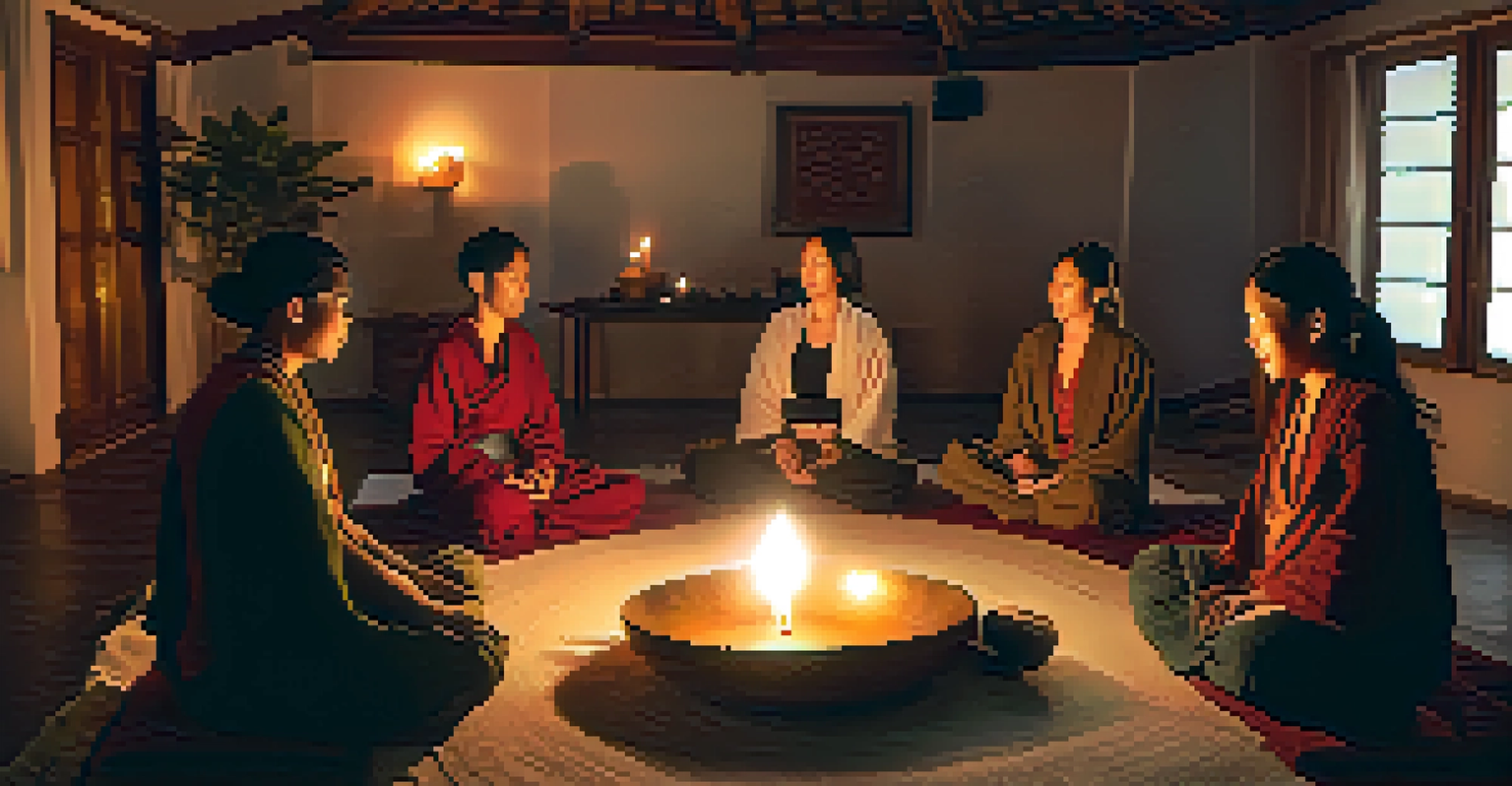The Influence of Yoga on Music Composition and Sound Healing

Understanding the Connection Between Yoga and Music
Yoga and music have a long-standing relationship that dates back centuries. Both practices aim to create harmony, whether in the mind, body, or spirit, making them natural companions. In many cultures, music has been used in yoga practices to enhance the experience and deepen the connection between the practitioner and their inner self.
Yoga is the journey of the self, through the self, to the self.
The rhythmic elements of music can mirror the flow of breath in yoga, guiding practitioners through poses and transitions. This synergy helps individuals maintain a steady pace and encourages mindfulness, making the practice more immersive. As a result, music becomes an essential tool for fostering a tranquil environment that promotes relaxation and introspection.
Moreover, the use of specific musical scales, such as the ancient Indian raga, can evoke different emotions and states of consciousness. This understanding allows composers to create pieces that resonate with the yoga experience, enhancing the overall journey of self-discovery and healing.
The Role of Sound in Yoga Practices
Sound plays a pivotal role in yoga, often manifesting through chanting, singing bowls, or soothing background music. These sounds can help practitioners focus their minds, making it easier to enter a meditative state. By incorporating sound into their practice, yogis can deepen their connection to the present moment.

Chanting 'Om' is a classic example of how sound can enhance the yoga experience. This sacred syllable is believed to represent the universe and can help practitioners align their vibrations with higher energies. As a result, the sound becomes a bridge connecting the physical practice to a deeper spiritual journey.
Yoga and Music Enhance Connection
The harmonious relationship between yoga and music creates a deeper connection to the self, fostering relaxation and introspection.
Additionally, sound healing techniques, such as using crystal bowls or tuning forks, are increasingly integrated into yoga classes. These instruments produce frequencies that can promote relaxation and healing, helping individuals release emotional blockages and restore balance within.
How Music Influences Emotional Expression in Yoga
Music has a unique ability to evoke emotions, and when paired with yoga, it can amplify the emotional experience. As practitioners flow through poses, the right music can inspire feelings of joy, sadness, or peace, allowing for a richer exploration of the self. This emotional release is essential for personal growth and healing.
Music can change the world because it can change people.
For example, a slow, melodic piece might encourage introspection, while an upbeat, lively track can motivate movement and enjoyment. Composers often consider these emotional arcs when creating music for yoga, aiming to enhance the overall experience. This intentional pairing encourages practitioners to fully engage with their emotions during their practice.
Furthermore, the relationship between music and emotion is backed by science. Studies have shown that listening to music can stimulate the same brain areas activated by physical activity, further connecting the mind-body experience during yoga. This underscores the profound impact that sound can have on our physical and emotional states.
Exploring Sound Healing Techniques in Yoga
Sound healing is a practice that utilizes sound frequencies to promote physical and emotional well-being. In yoga, sound healing can take many forms, including guided meditations or sound baths where participants are enveloped in soothing sounds. These techniques are designed to help individuals relax and connect with their inner selves.
One popular method is the use of Tibetan singing bowls, which produce resonant sounds that can help clear energy blockages. When placed on or around the body, these bowls create vibrations that resonate with the chakras, encouraging balance and healing. This integration of sound into yoga practices enhances the therapeutic benefits of both disciplines.
Sound Healing Promotes Wellness
Integrating sound healing techniques into yoga practices enhances emotional release and physical restoration, creating a holistic approach to wellness.
Moreover, sound healing can also be a communal experience, fostering a sense of connection among participants. Sharing in the healing power of sound can create a supportive environment that encourages openness and vulnerability, ultimately enriching the yoga journey.
The Impact of Music Composition on Yoga Classes
The choice of music in yoga classes can significantly influence the atmosphere and overall experience. Instructors often curate playlists that align with the energy of the class, whether it’s a gentle restorative session or a dynamic power flow. This thoughtful approach ensures that the music complements the physical and emotional aspects of the practice.
Moreover, skilled composers understand how to craft tracks that build and release tension, mirroring the flow of the yoga practice. For instance, an increasing tempo can accompany a challenging series of poses, while a soft, calming melody can signal a return to restorative breathing. This dynamic interplay between music and movement enhances the flow of the class.
Ultimately, the combination of well-composed music and mindful movement creates a powerful experience that resonates with participants on multiple levels. As yoga continues to evolve, the role of music composition will remain a vital element in shaping the practice.
Integrating Yoga and Music in Healing Practices
Integrating yoga and music into healing practices creates a holistic approach to wellness. Many practitioners find that combining movement with sound can accelerate the healing process, allowing for deeper emotional release and physical restoration. This synergy not only promotes relaxation but also fosters a sense of community and support.
Incorporating elements such as live music or guided sound journeys during yoga sessions can enhance the therapeutic effects. These experiences provide a safe space for individuals to explore their emotions and connect with others on a similar journey. The shared experience of sound and movement can be incredibly powerful.
Future Trends in Yoga and Sound
Emerging trends in yoga and sound healing, including technology and specialized classes, highlight the growing appreciation for the therapeutic benefits of music.
Furthermore, this integrative approach is gaining recognition in various therapeutic settings, including mental health and rehabilitation. As more professionals embrace the benefits of merging yoga with music, we can expect to see a growing trend in sound healing practices that prioritize the mind-body connection.
Future Trends in Yoga, Music, and Sound Healing
As the fields of yoga and sound healing continue to evolve, we can anticipate exciting trends emerging at their intersection. One potential development is the increased use of technology, such as apps that offer guided sound experiences tailored to individual needs. This innovation could make sound healing more accessible to a wider audience.
Additionally, more yoga studios may begin to offer specialized classes that focus exclusively on the therapeutic benefits of sound. By integrating live performances from musicians or sound healers, these sessions can create a unique atmosphere that enhances the practice. This shift reflects a growing understanding of the importance of sound in promoting holistic well-being.

In conclusion, the future of yoga and music is bright, with endless possibilities for exploration and growth. As more individuals recognize the profound impact of sound on their practice, we can expect to see a greater appreciation for the healing power of music in the yoga community.